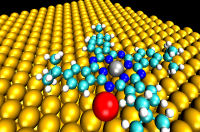German researchers have now succeeded in deciphering how micrometric motors work. Their findings could aid in the development of extremely tiny and highly efficient steam engines

German researchers from the Max Planck Institute have now succeeded in deciphering how micrometric motors work. Their findings could aid in the development of extremely tiny and highly efficient steam engines.
A technology operating on a large scale may trigger unexpected problems on a small scale, and these may be intrinsically material. This is due to the fact that different laws govern the microscopic and macroscopic world. Despite the different laws, certain physical processes are surprisingly similar on both a small and large scale. Researchers from the University of Stuttgart and the Max Planck Research Institute have now discovered one of these similarity factors.
"We developed the world's smallest steam engine and found that this machine does work," said the lead researcher. "This finding was not necessarily expected since the machine is so small that its movement is inhibited by microscopic processes that are not at all taken into account in the macroscopic world." These disturbances cause the micromachine to operate in an indelicate manner.
The laws of the macroscopic world dictate that researchers cannot build a tiny engine based on the blueprint of a full-sized engine. In a heat engine, invented about two hundred years ago by Robert Stirling, a cylinder filled with gas is heated and cooled cyclically so that the gas expands and contracts repeatedly. This system allows the piston to perform an action that can be used to move a wheel, for example.
"We managed to minimize the size of the necessary components in a heat engine, such as the piston, to only a few micrometers and then assembled them to receive a machine," says one of the researchers. The gas operating in the new system does not now consist of countless molecules, but a single type of plastic bead only three micrometers in size that floats on water. Since the particle is 10000 times larger than a single atom, researchers are able to directly observe its movement with a microscope.
The physicists replaced the piston, which moves up and down cyclically inside the cylinder, with a focused laser beam whose intensity changes cyclically. The optical forces of the laser limit the movement of the plastic particle, similar to the expansion and contraction of the gas in the cylinder of a normal heat engine. So, the particle performs work on the optical laser field. So that the contributions to the work do not offset each other during the expansion and contraction, these steps should be carried out at different temperatures. This is done by heating the system from the outside during the expansion process, just as is done by the boiler of a steam engine. The researchers replaced the heat generated in the steam engine, which originates from burning coal, with an additional laser beam that heats the water immediately, and at the same time allows it to cool as soon as its activity is stopped.
The reason the machine of the German researchers moves without refinement is the presence of the water molecules that surround the plastic bead. The water molecules are in constant motion due to their temperature and are constantly colliding with the microparticle. In these random collisions, the plastic particle constantly transfers energy to its environment in the same order of magnitude as the micromachine converts energy into work. "This result means that the amount of energy obtained varies significantly from cycle to cycle, and even causes the machine to be disabled from its operation in the extreme case," explains one of the researchers. Since macroscopic machines convert energy about twenty orders of magnitude more, the energies of the tiny collisions of the smallest particles occurring within it are unimportant.
The physicists are all the more surprised that the machine converts so much energy in each cycle, on average, despite the varying energy, and even operates at the same level of efficiency as its macroscopic counterpart at full load. "Our experiments provide us with a preliminary insight into the energy balance of a heat engine operating in microscopic dimensions. Although our machine does not provide any useful work at the moment, in principle there is no thermodynamic obstacle preventing it from doing so in these small dimensions," explains the researcher. The findings are especially important and fascinating for the design and development of reliable micromachines with high efficiency.
The news about the study
